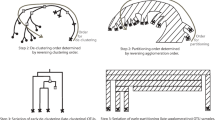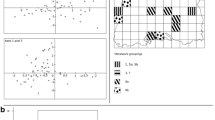Abstract
The aim of this article is to summarize and organize the methodologies used for the statistical analysis in the field of ceramic investigation and, more specifically, the study of ceramic provenance. An update and review of all related methodologies is provided during the presentation of a typical statistical analysis. The presentation is given in a step-by-step process and emphasis is on interpretation of the intermediate and final results. The analysis attempts to cover the following:
-
What issues to examine in a preliminary analysis
-
Data transformation
-
Cluster analysis
-
Clustering assessment
-
Data dimension reduction methods as part of a clustering visualization and assessment
-
Outliers and small groups
-
Mixed-mode analysis
-
Cluster characterization and discriminating factors
-
Classification











Similar content being viewed by others
References
Aitchison J (1986) The statistical analysis of compositional data. Chapman & Hall, London
Aloupi-Siotis E (2020) Ceramic technology. How to characterise black Fe-based glass-ceramic coatings. Archaeol Anthrop Sci. https://doi.org/10.1007/s12520-020-01134-x
Angourakis A, MartínezFerreras V, Torrano A, GurtEsparraguera JM (2018) Presenting multivariate statistical protocols in R using Roman wine amphorae productions in Catalonia, Spain. J Archaeol Sci 93:150–165
Banfield JD, Raftery AE (1993) Model-based Gaussian and non-Gaussian clustering. Biometrics 49:803–821
Baker FB, Hubert LJ (1975) Measuring the power of hierarchical cluster analysis. J Am Stat Assoc 70:31–38
Barcelo JA, Bogdanovic I (2015) Mathematics and archaeology. CRC Press, Boca Raton
Baxter MJ (1995) Standardization and transformation in principal component analysis, with applications to archaeometry. Applied Statist 44(4):513–527
Baxter MJ (2001) Statistical modelling of artefact compositional data. Archaeometry 43(1):131–147
Baxter MJ (2006) A review of supervised and unsupervised pattern recognition in archaeometry. Archaeometry 48(4):671–694
Baxter MJ (2008) Mathematics, statistics and Archaeometry – the last 50 years or so. Archaeometry 50(6):968–982
Baxter MJ (2015a) Exploratory multivariate analysis in archaeology (foundations of archaeology), 2nd edn. Eliot Werner Publications/Percheron Press
Baxter MJ (2015b) Spatial k-means clustering in archaeology – variations on a theme. Working paper – November 2015 (accessed in Academia.edu)
Baxter MJ, Beardah CC, Papageorgiou I, Cau PM, Day PM, Kilikoglou V (2008) On statistical approaches to the study of ceramic Artefacts using geochemical and petrographic data. Archaeometry 50:142–157. https://doi.org/10.1111/J.1475-4754.2007.00359.X
Beardah CC, Baxter MJ, Cool HEM, Jackson CM (2003) Compositional data analysis of archaeological glass: problems and possible solutions. CoDaWork’03: Compositional Data Analysis Workshop, Girona, Spain Available at http://ima.udg.es/Activitats/CoDaWork03/paper\_baxter\_Beardah2.pdf
Bieber AM Jr, Brooks DW, Harbottle G, Sayre EV (1976) Application of multivariate techniques to analytical data on Aegean ceramics. Archaeometry 18:59–74
Binford LR (1964) A consideration of archaeological research design. Am Antiq 29(4):425–441
Campello RJGB (2007) A fuzzy extension of the Rand index and other related indexes for clustering and classification assessment. Pattern Recogn Lett 28:833–841
Charrad M, Ghazzali N, Boiteau V, Niknafs A (2014) NbClust: an R package for determining the relevant number of clusters in a data set. J Stat Softw 61(6):1–36 http://www.jstatsoft.org/v61/i06/
de Lapérouse J-F (2020) Ceramic musealisation: How ceramics are conserved and the implications for research. Archaeol Anthrop Sci. https://doi.org/10.1007/s12520-020-01139-6
Drennan RD (2009) Statistics for archaeologists. In: A common sense approach, Second edn. Springer
Egozcue JJ (2009) Reply to “On the Harker Variation Diagrams; …” by J.A. Cortés. Math Geosci 41:829–834
Eramo G (2020) Ceramic technology. How to recognize clay processing. Archaeol Anthrop Sci. https://doi.org/10.1007/s12520-020-01132-z
Everitt BS, Landau S, Leese M (2011) Cluster analysis, 5th edn. John Wiley & Sons
Everitt BS, Dunn G (2001) Applied multivariate data analysis, 2nd edn. John Wiley & Sons
Fowlkes EB, Mallows CL (1983) A method for comparing two hierarchical clusterings. J Am Stat Assoc 78:553–569
Filzmoser P, Garrett RG, Reimann R (2005) Multivariate outlier detection in exploration geochemistry. Comput Geosci 31:579–587
Filzmoser P, Hron K, Templ M (2018) Applied compositional data analysis with worked examples in R. Springer
Galli A, Sibilia E, Martini M (2020) Ceramic chronology by luminescence dating. How and when it is possible to date ceramic artefacts. Archaeol Anthrop Sci. https://doi.org/10.1007/s12520-020-01140-z
Gliozzo E (2020a) Ceramics investigation, Research questions and sampling criteria. Archaeol Anthrop Sci. https://doi.org/10.1007/s12520-020-01128-9
Gliozzo E (2020b) Ceramic technology. How to reconstruct the firing process. Archaeol Anthrop Sci. https://doi.org/10.1007/s12520-020-01133-y
Glascock MD (2016) Compositional analysis in archaeology. Oxford Handbooks, Oxford Handbooks Online, pp 1–25
Greenacre M (2018) Compositional data analysis in practice. Chapman and Hall/CRC
Gower JC (1971) A general coefficient of similarity and some of its properties. Biometrics 27(4):857–871
Gower JC, Legendre P (1986) Metric and Euclidean properties of dissimilarity coefficients. J Classif 5:5–48
Gualtieri S (2020) Ceramic raw materials, How to establish the technological suitability of a raw material. Archaeol Anthrop Sci. https://doi.org/10.1007/s12520-020-01135-w
Halkidi M, Batistakis Y, Vazirgiannis M (2001) On clustering validation techniques. J Intell Inf Syst 17:107–145
Hein A, Kilikoglou V (2020) Ceramic raw materials, How to recognize them and locate the supply basins. Chemistry. Archaeol Anthrop Sci. https://doi.org/10.1007/s12520-020-01129-8
Henderson J, Ma H, Cui J, Ma R, Xiao H (2020) Isotopic investigations of Chinese ceramics. Archaeol Anthrop Sci. https://doi.org/10.1007/s12520-020-01138-7
Hubert L, Arabie P (1985) Comparing partitions. J Classif 2:193–218
Ionescu C, Hoeck V (2020) Ceramic technology. How to investigate surface finishing. Archaeol Anthrop Sci. https://doi.org/10.1007/s12520-020-01144-9
James G, Witten D, Hastie T, Tibshirani R (2013) An introduction to statistical learning with applications in R. Springer, New York
Jolliffe IT (2002) Principal component analysis. Springer
Kassambara A (2017) Practical guide to cluster analysis. In: R. Unsupervised machine learning: volume 1 (multivariate analysis). STHDA Publishing
Maritan L (2020) Ceramic abandonment. How to recognise post-depositional transformations. Archaeol Anthrop Sci. https://doi.org/10.1007/s12520-020-01141-y
Martín-Fernández JA, Buxeda i Garrigós J, Pawlowsky-Glahn V (2015) Logratio analysis in archeometry: principles and methods. In: Barcelo JA, Bogdanovic I (eds) Mathematics and archaeology. CPC press, Boca Raton FL, pp 178–189
Montana G (2020) Ceramic raw materials. How to recognize them and locate the supply basins. Mineralogy, Petrography. Archaeol Anthrop Sci. https://doi.org/10.1007/s12520-020-01130-1
Palarea-Albaladejo J, Martín-Fernández JA (2015) zCompositions — R package for multivariate imputation of left-censored data under a compositional approach. Chemom Intell Lab Syst 143:85–96
Papageorgiou I (2018) Cluster analysis. In: The SAS Encyclopedia of Archaeological Sciences. John Wiley & Sons. https://doi.org/10.1002/9781119188230.saseas0099
Papageorgiou I, Baxter MJ, Cau MA (2001) Model-based cluster analysis of artefact compositional data. Archaeometry 43:571–588
Papageorgiou I, Moustaki I (2005) Latent class models for mixed variables with applications in archaeometry. Comput Stat Data An 48:659–675
Pawlowsky-Glahn V (2003) Statistical modelling on coordinates. In: Thio-Henestrosa S, Martin-Fernandez JA (eds) Compositional data analysis workshop-CoDaWork’03, Proceedings. University of Girona, Girona
Pawlowsky-Glahn V, Egozcue JJ, Tolosana-Delgado R (2015) Modeling and analysis of compositional data. John Wiley & Sons, Springer, London, UK
Pradell T, Molera J (2020) Ceramic technology. How to characterise ceramic glazes. Archaeol Anthrop Sci. https://doi.org/10.1007/s12520-020-01136-9
Rand WM (1971) Objective criteria for the evaluation of clustering methods. J Am Stat Assoc:846–850
Rogers S, Girolami M (2016) A first course in machine learning, 2nd edn. Chapman and Hall
Rousseeuw P, Van Zomeren B (1990) Unmasking multivariate outliers and leverage points. J Am Stat Assoc 85:633–639
Rousseeuw PJ (1987) Silhouettes: a graphical aid to the interpretation and validation of cluster analysis. J Comput Appl Math 20:53–65
Saraçli S, Doğan N, Doğan İ (2013) Comparison of hierarchical cluster analysis methods by cophenetic correlation. J InequalAppl 2013:203. https://doi.org/10.1186/1029-242X-2013-203
Sciau P, Sanchez C, Gliozzo E (2020) Ceramic technology. How to characteriseterra sigillata ware. J Am Stat Assoc. https://doi.org/10.1007/s12520-020-01137-8
Shotwell MS (2013) profdpm: an R package for MAP estimation in a class of conjugate product partition models. J Stat Soft 53:1-18. http://www.jstatsoft.org/v53/i08/
Sokal RR, Rohlf FJ (1962) The comparison of dendrograms by objective methods. Taxon 11:33–40
Steinley D (2006) K-means clustering: a half-century synthesis. Br J Math Stat Psychol 59:1–34
Schwarz G (1978) Estimating the dimension of the model. Ann Stat 6:461–464
Thér R (2020) Ceramic technology, How to reconstruct and describe pottery-forming practices. Archaeol Anthrop Sci. https://doi.org/10.1007/s12520-020-01131-0
Thomas DH (1978) The awful truth about statistics in archaeology. Am Antiq 43:231–244
Van den Boogaart KG, Tolosana-Delgado R (2013) Analyzing compositional data with R. Springer, Berlin Heidelberg
Whallon R (1984) Unconstrained clustering for the analysis of spatial distributions in archaeology. In: Hietala HJ (ed) Intrasite spatial analysis in archaeology. Cambridge University Press, New York, pp 242–277
Wickham H (2009) ggplot2: elegant graphics for data analysis. Springer, New York
Xu R, Wunsch-II DC (2008) Clustering. Wiley, John & Sons, Inc
Author information
Authors and Affiliations
Corresponding author
Ethics declarations
Conflict of interest
The author declares that there are no conflicts of interest.
Additional information
Publisher’s note
Springer Nature remains neutral with regard to jurisdictional claims in published maps and institutional affiliations.
This article is a Topical Collection on Ceramics: Research questions and answers
Rights and permissions
About this article
Cite this article
Papageorgiou, I. Ceramic investigation: how to perform statistical analyses. Archaeol Anthropol Sci 12, 210 (2020). https://doi.org/10.1007/s12520-020-01142-x
Received:
Accepted:
Published:
DOI: https://doi.org/10.1007/s12520-020-01142-x




